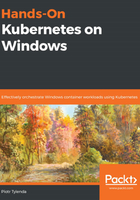
LinuxKit LCOW and Hyper-V isolation
Contrary to the MobyLinuxVM approach, Linux Containers on Windows (LCOW) uses Hyper-V isolated containers to achieve similar results. LCOW is available for Windows 10, which comes with Docker for Windows 17.10, and for Windows Server, version 1709, which comes with a preview release of Docker Enterprise Edition.
The main difference compared to MobyLinuxVM is the possibility to natively run Linux and Windows containers side by side using the same Docker Daemon. This solution is the current strategy for supporting Linux containers running on Windows but as the long-term solution, in June 2019, Docker and Microsoft started a collaboration to integrate the Windows Subsystem for Linux version 2 as the primary Linux container runtime on Windows. Eventually, both LinuxKit LCOW and MobyLinuxVM with Docker Desktop for Windows will be retired.
The following diagram shows LCOW:

In order to enable LCOW support in Docker Desktop (version 18.02 or later), you have to enable the Experimental features option in Docker Settings > Daemon. Creating an LCOW container requires specifying the --platform linux parameter (if platform selection is unambiguous, that is, the image only exists in Linux, then it can be omitted in newer versions of Docker Desktop):
docker run -it --platform linux busybox /bin/sh
The preceding command will create a busybox Linux container and enter the interactive Bourne shell (sh).
("batteries included")with the LCOW feature enabled.
In this section, you learned how containers are currently supported on the Windows platform and the key differences between the provided runtimes. Now, we can start installing Docker Desktop for Windows.